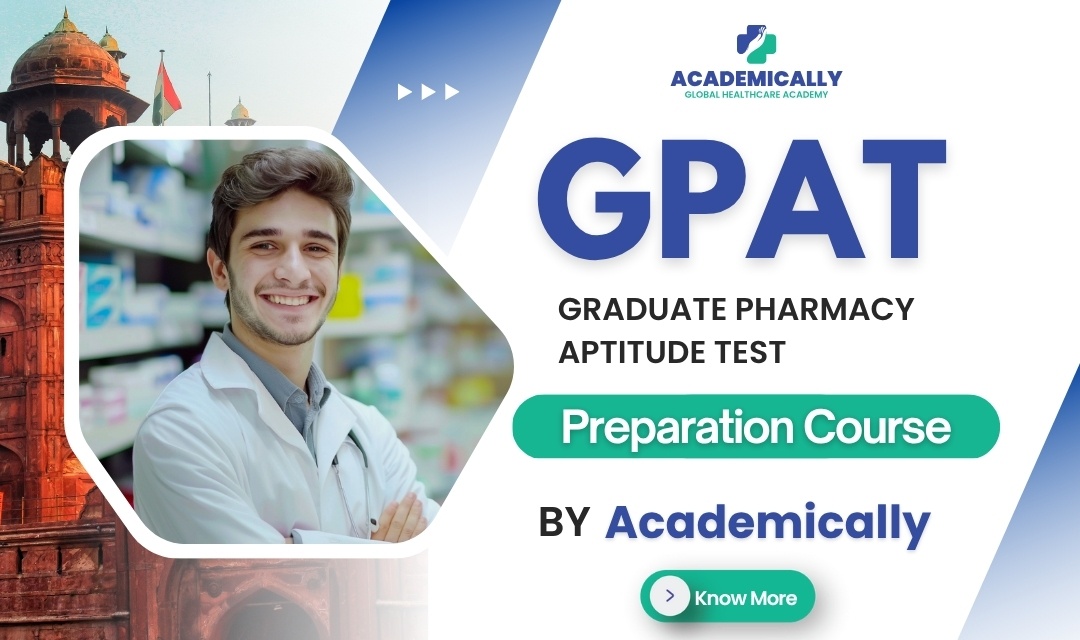If you’re aiming to crack GPAT 2026, this is the only guide you need to read. Because let’s face it, most students waste months flipping through random notes and PDFs, never really understanding what to study and how to study.
But you? You’re going to be smarter.
This complete GPAT syllabus breakdown isn’t just another copy of the official notification; it’s a clear, practical, and student-friendly roadmap designed to help you focus on what actually matters.
GPAT 2025 Overview
Here’s everything you need to know before you even begin:
| Category | Information |
| Exam Conducted By | National Board of Examinations in Medical Sciences (NBEMS) |
| Exam Format | Computer-Based Test (CBT) conducted online |
| Language | English |
| Exam Frequency | Conducted once every year |
| Total Duration | 3 Hours (180 Minutes) |
| Type of Questions | Multiple Choice Questions (MCQs) |
| Number of Questions | 125 |
| Total Score | 500 Marks |
| Official Portal | www.natboard.edu.in |
Want structured preparation that covers every subject of GPAT with expert guidance?
The GPAT 2026 Syllabus Pattern You Can’t Afford to Ignore
The exam is a computer-based test with multiple-choice questions. But what makes GPAT unique is how cleverly it mixes subjects from your entire B.Pharm journey.
Here’s the official blueprint you need to plan around:
| Subjects | No. of Questions | Marks |
| Pharmaceutical Chemistry & Allied Subjects | 38 | 152 |
| Pharmaceutics & Allied Subjects | 38 | 152 |
| Pharmacology & Allied Subjects | 28 | 112 |
| Pharmacognosy & Allied Subjects | 10 | 40 |
| Other Subjects (B.Pharm Course) | 11 | 44 |
| Total | 125 | 500 |
Each question = 4 marks
Wrong answer = -1 mark
So every guess has a price, and precision is everything.

GPAT 2026 Syllabus: Subject-Wise Deep Dive
Now let’s go straight to the heart of your preparation, what to study, what not to, and how to master each subject.
1. Pharmaceutical Chemistry & Allied Subjects (38 Qs / 152 Marks)
If GPAT were a movie, Pharmaceutical Chemistry would be the lead actor. It’s vast, conceptual, and carries serious weight.
Key Topics:
- Organic Chemistry: Reaction mechanisms, stereochemistry, and named reactions.
- Medicinal Chemistry: SAR, drug design, classification, mechanism of action, and clinical use.
- Inorganic & Analytical Chemistry: Impurities, assays, spectroscopy (UV, IR, NMR, MS), and chromatography (HPLC, TLC, GC).
Smart Tip: Instead of cramming reactions, focus on why and how a reaction happens; that’s what GPAT actually tests.
2. Pharmaceutics & Allied Subjects (38 Qs / 152 Marks)
This section is pure pharmacy science, the art of turning chemicals into medicines.
Topics You Must Know:
- Physical Pharmacy: Diffusion, solubility, particle size, and rheology.
- Dosage Forms: Tablets, capsules, suspensions, emulsions, and parenteral products.
- Biopharmaceutics & Pharmacokinetics: ADME (absorption, distribution, metabolism, excretion).
- Novel Drug Delivery Systems (NDDS): Liposomes, nanoparticles, and transdermal systems.
- Pharmaceutical Engineering & GMP: Validation, sterilization, and cleanroom operations.
Exam Tip: Questions are often numerical; learn the core formulas for diffusion, dissolution, and bioavailability.
3. Pharmacology & Allied Subjects (28 Qs / 112 Marks)
Here’s where you study how drugs actually work inside the body — the logic behind every prescription.
Focus Areas:
- General Pharmacology: Pharmacokinetics, pharmacodynamics, and dose-response curves.
- Autonomic Nervous System: Adrenergic, cholinergic, and neuromuscular agents.
- Cardiovascular, CNS, and Endocrine Drugs: Mechanisms and adverse effects.
- Chemotherapy: Antibiotics, antifungals, antivirals, and anticancer drugs.
- Toxicology: Poisoning, antidotes, and adverse drug reactions.
Pro Tip: Make charts for drug classifications and mechanisms, they save time and stick better in memory.
4. Pharmacognosy & Allied Subjects (10 Qs / 40 Marks)
Nature has been a pharmacist for centuries. This section celebrates that.
What to Study:
- Sources of drugs (plants, animals, minerals)
- Phytochemistry: Alkaloids, glycosides, tannins, terpenoids
- Extraction, isolation, and standardization methods
- Herbal formulations and quality control
Quick Win: Memorize the active constituents and uses of major plants. These are short, crisp, and scoring.
5. Other B.Pharm Subjects (11 Qs / 44 Marks)
This group is often ignored, but it’s your hidden score booster.
Includes:
- Biochemistry: Enzymes, metabolism, and energy cycles
- Microbiology: Sterilization, immunity, and pathogenic microbes
- Pathophysiology: Disease mechanisms
- Pharmaceutical Jurisprudence: Drug laws, ethics, and trial regulations
Scoring Secret: These questions are usually direct and factual. A few quick revisions can give you full marks here.

How to Use This Syllabus the Smart Way
Now that you know what to study, let’s talk about how to prepare effectively.
1. Start Early, Start Smart
Begin your GPAT prep at least 6–8 months before the exam. Break your syllabus into weekly goals instead of random topics.
2. Prioritize Weightage
Pharmaceutical Chemistry + Pharmaceutics = 60% of your paper.
Make them your power subjects.
3. Notes > PDFs
Handwritten notes work wonders. Summarize each topic in your own words — it improves recall by 2x.
4. Practice Mock Tests
GPAT is about accuracy under pressure. Take weekly AI-based mock tests (like the ones offered by Academically) to build real exam stamina.
5. Revise, Don’t Rote
Make one-page summaries, flashcards, and short quizzes for each subject. Smart revision beats last-minute panic.
Must-Have GPAT Resources
Here are some trusted sources every topper uses:
- Books:
- Essentials of Medical Pharmacology – K.D. Tripathi
- Comprehensive Pharmacy Review – Leon Lachman
- Organic Chemistry – Morrison & Boyd
- Trease and Evans Pharmacognosy
- Online Tools:
- AI-powered GPAT mock tests by Academically
- NBE official website for syllabus & updates
- YouTube concept videos for last-minute revision
Final Thoughts: Your GPAT Journey Starts Now
GPAT isn’t just an exam; it’s your gateway to a career that shapes healthcare and innovation. So stop scrolling, start strategizing, pick one subject, one topic, and begin today.
Because every top scorer once stood exactly where you are now, confused, overwhelmed, and uncertain, until they took that first small step.